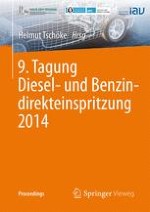2015 | OriginalPaper | Chapter
Development of Fuel Injection Control Technology in Gasoline Direct Injection Engine
Authors : Frank Drautz, Dipl.-Ing., Kengo Kumano, Kenichi Machida, Henning Sauerland, Dr.
Published in: 9. Tagung Diesel- und Benzindirekteinspritzung 2014
Publisher: Springer Fachmedien Wiesbaden
Activate our intelligent search to find suitable subject content or patents.
Select sections of text to find matching patents with Artificial Intelligence. powered by
Select sections of text to find additional relevant content using AI-assisted search. powered by
Fuel injection control technologies in gasoline direct injection engines aiming at reduction of exhaust emissions (particulate matter and hydrocarbons) and supression of knocking were developed.
1) Particulate matter emission reduction
A technique of estimating particulate matter (PM) from gasoline direct injection engines is proposed that is used to compute mass density and particle number density of PM by using fuel mass in rich mixtures obtained from non-combustion computational fluid dynamics (CFD). PM emissions from a single-cylinder gasoline direct injection engine were measured to determine the model constants that were required in the estimation model. We confirmed that the technique could be applied to various engine operating conditions and fuel spray patterns. Because combustion-phase calculations are not required to estimate PM with the method, it has been a useful way of exploring optimum injection timing and/or spray specifications within short periods. Split injection to reduce PM was investigated with the method. PM was significantly reduced with split-injection by optimizing the injection timing.
2) Hydrocarbon emission reduction
A combustion concept was proposed to reduce unburnt total hydrocarbons (THC) during catalyst heating. The retarded ignition control with the split injection, the 1st injection timing is the later period of compression stroke and the 2nd one is the early period of expansion stroke was able to reduce THC up to 33% in comparison with a conventional method. Combustion stability at retarded ignition was improved exceedingly by using the asymmetric fuel-spray directed under the spark plug and the stepshaped piston. The fuel injected at the 1st injection timing was guided around the spark plug so stable stratified mixture was generated until 30degATDC.
3) Knocking suppression
The effect of the hot EGR on knocking phenomenon was investigated quantitatively by CFD, and a knock suppression method was proposed. The hot spots due to the residual gas (hot EGR) exist in the combustion chamber after compression stroke, and contribute to the occurrence of auto-ignition that leads to a knocking. Multiple fuel injection, which includes the early injection in the intake stroke is able to decrease the temperature of the hot spots and makes the combustion phasing at knocking limit advanced by 2 [deg.CA] without increasing the smoke emission. Cooling the hot spot (hot EGR) by multiple fuel injection is effective to minimize the negative effect of hot EGR on the knocking.
